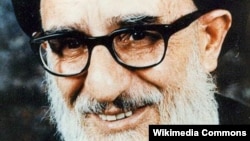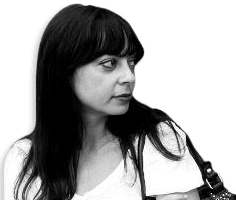A major reformist Iranian daily has created controversy by altering an iconic image of a prominent deceased cleric to remove a cigarette he was holding.
The cleric, Ayatollah Mahmud Taleghani, a key figure of the 1979 Islamic Revolution who became Tehran's first Friday Prayers leader after the revolution, was a known chain smoker who wasn't shy about his habit.
So, when the daily Sharq posted one of Taleghani's most famous pictures on its front page alongside a story marking the anniversary of the cleric's first Friday Prayers sermon, the missing cigarette did not go unnoticed.
Social-media users criticized the move, with many posting the original photo showing a pensive-looking Taleghani holding a cigarette in his right hand.
Some questioned whether the content of a daily that publishes doctored photos could be trusted.
Others poked fun at Sharq's airbrushing by posting memes in which Taleghani is seen holding various things in place of the missing cigarette.
The doctoring job has cast attention on media censorship in the Islamic republic, where publications face tough state restrictions while at the same time practicing self-censorship in order to prevent being shut down by the authorities.
Taleghani's son, Mehdi Taleghani, blasted Sharq's doctoring as "a clear example of censorship."
"It means portraying people to society the way we want, and removing the parts we don't [like]," he added.
The deceased cleric's son noted that his father appears in dozens of other photographs with a cigarette. "Some see [smoking] as a bad habit, but my father wasn't trying to hide it," he said.
"I don't understand how a media outlet allows itself to remove this aspect of Taleghani," he told the news site Nasimonline.ir.
The author of the photo, Iranian-born Magnum photographer Abbas, also criticized Sharq for censoring his work, saying in an open letter published on Iranwire.com that he was sure Ayatollah Taleghani would not appreciate the daily depicting him as a "nonsmoker."
"I noticed you published my photo of Ayatollah Taleghani without my permission. I am aware there are no copyright laws in Iran, but the least you could do was to publish the photo whole -- with the cigarette in Taleghani's right hand," Abbas wrote in a letter to Sharq.
"One starts by erasing a cigarette and ends up erasing Trotsky! (in case you do not know, this refers to the famous photo of Trotsky -- standing next to Lenin --which was erased.)"
"For your information, I also have a photo of Ayatollah Khamenei smoking a pipe," Abbas added.
The photo alteration was also mocked by Sharq reporter Mehdi Ghadimi, who posted an anecdote on Twitter about Taleghani's smoking habit as recounted by deceased senior Ayatollah Mohammad Ali Montazeri, who shared a prison cell with Taleghani in 1977.
"One night [Taleghani] was smoking nonstop. I told him: 'We're choking from the smoke. Why don't you go to sleep?'"
Sharq editor in chief Mehdi Rahmanian suggested that the daily had airbrushed the cigarette out of Taleghani's hand in order to avoid promoting smoking. "The photo of Ayatollah Taleghani with a cigarette is, in a way, a promotion of cigarettes," Rahmanian told the Mizan news agency. "We didn't want this to happen."
He highlighted written and unwritten censorship rules publications face in the Islamic republic. "I'm not sure if a photo with a cigarette is banned by law or not. But as far as I know it faces some restrictions, meaning that media are not allowed to [publish] it," Rahmanian said.
Photographer Arash Ashourinia weighed in on the controversy by writing about his experience as a former photo editor of a number of publications and highlighting the plight of editors, who often have to second-guess the outcome of their editorial decisions.
"This is not a permanent and predictable issue," Ashourinia wrote on Facebook. "Based on whether the subject is a cleric or not, political or not, based on the political atmosphere in the country, the stances of the daily or magazine, its circulation, ...such a picture can easily lead to the closure of a daily."
The photographer added that what Sharq did and what many other Iranian publications do on a daily basis is wrong. But he reminded readers that their main criticisms should target the "system of censorship in the Islamic republic and the self-censorship that results from it."
(For a photo gallery of a sample of photographs censored in Iran, click here)






